What I learned about interfaces in the real world in China
Here is a typical form of connecting to Wi-Fi. It is actually on a huge page with a bunch of hieroglyphs, but the gray background helped me to understand that this is the most important form of connection, and the rest is help and advertising.
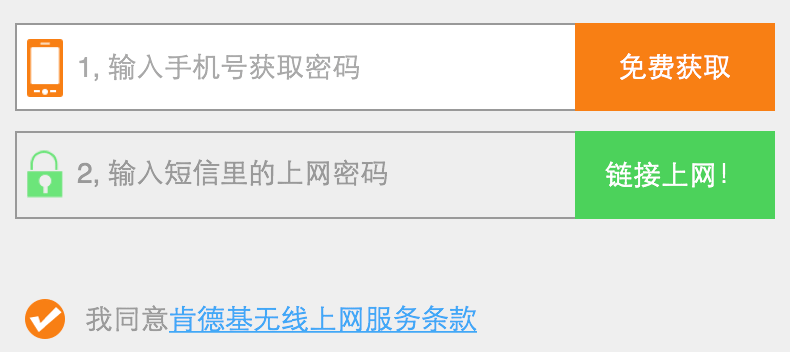
Icons are important. Judging by them, the tick below is, almost certainly, "I agree with the terms." The phone number at the top is probably a number. Next - the lock is the password. Both fields are active, that is, I must have a username and password right away, right?
')
No, nifiga, the Chinese UX means that I will first enter the phone and press the orange button (the colors of the icon - and yes, this is the button!). I will receive the password and enter it in the second field, and then press the green button. The robot will compare the phone with a password and let me go on. This form is most likely painted by a Chinese.
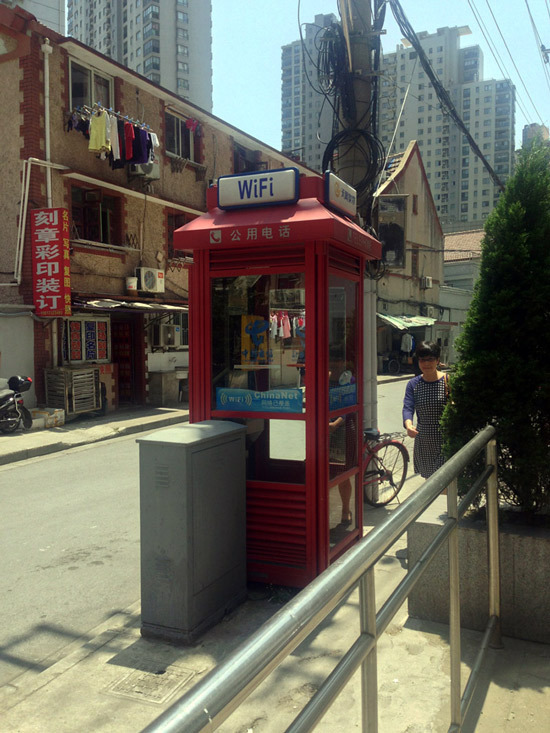
And this is the usual telephone booth of the early space age
Now I will show a few more things born in a country where there are about twenty times more qualified engineers than in America, and the state of inventiveness of the “Soviet engineer” has not yet passed. Of course, I will continue my story again and show the interfaces in the real world - they are no less interesting from the point of view of usability than HCI, and no less useful for understanding how to work with the user.
But the same form as above, only drawn by a European:

But let's go ahead and see what interesting things Chinese thought gives rise to. Here is the "do not disturb" checkbox on the switch. Because the switch is a natural chebox. They turned on in the room, your display lit up, a sign lit up in the hallway outside the door.

Here is a similar element in iOS:

This composition suggests that the Chinese love backups and think with their heads about emergency situations. In expensive hotels almost everywhere there is a shelf for a telephone in the bathroom and a parallel telephone. There is also the same switch as above about “do not disturb”, only with the words “ask the guest to wait”.

Here is this thing complement each tourist at the hotel reception:

On the front side it says something like “take this idiot to a hotel at such-and-such address”, on the B side, addresses to poke a finger into the taxi driver. Bottom line - a number is written into it when a taxi was ordered by a concierge so that a stupid tourist would not lure the car. Elegant and very cool. You encounter a roughly similar navigation pattern several times a day:

Spade smartphones have long been a part of culture. Here, for example, in the train holder. We still have to poke the phone in a jacket or wrap it in a towel and put it on the net shelf:

The issue with children and tickets is solved very cool. Let me remind you of our age. An age without complicated movements cannot be checked. In China, the check interface is many times simpler (yes, accuracy suffers a little, but this is not the main thing, right?):

Continuing about the hotel - there is often a “mixing console” near the bed, on which all the room switches are connected. You can turn off the light in the toilet without getting up.

Below, by the way, are often a respirator, an oxygen bottle and white slippers.
Here is more interesting. Some panels are full duplex, that is, when you click "turn off" change the state and controlled switch. In this case, the switch is a touch panel - it is quite difficult for the physical to click. That is, we change the predictability of the interface to the convenience of the user. On the other hand, most of the panels create a second break in the circuit, and in order to turn the light back on, you must first close the circuit from the panel again. But the switches are good old mechanical. The global OS control panels seem to behave remotely - sometimes you can reach the settings of something only from there, sometimes from the application, and sometimes from the application and from the panel, and what you end up with and survive is a surprise.
But we will continue. So that the client does not put something extra in the package, we tie it up. In China, they simply print a zero price tag on the scales and stick it to them. Excellent use of not only the information component (code), but also the media. Such a glue without damage to the package will not lag behind:

Given that the main problem of the country is to cope with different types of DDoS on infrastructure due to the large number of users, excellent solutions are born. Here, for example, there are toilets in the train separately, and washrooms separately. The excellent principle of TRIZ is separation. Now, cleaning teeth do not break the lives of those who ate something wrong:

So that you better understand the depth of the problem of busy toilet, please note that the trains there are three-storeyed:

Anything that can be poddoseno will be poddoseno. Plus, they do not believe in the queue here, and therefore they immediately build a whole system of labyrinths around the cash registers. The labyrinth architecture itself forces people to keep order. This is also a great interface example of learning. Here you can not do wrong, even if you come from the village do not know how to stand in line:

Accordingly, if “it is impossible” - then it is not a symbol, but a physical limitation. For example, all double solid on the main roads of Beijing at least 40 centimeters in height and of concrete. Or hello to the electricians:

Very often animation is used to indicate dangerous things - because moving things are more visible. At night on the dangerous parts of the road LED moving arrows or flashers. But the machine that can stand and repair the track.
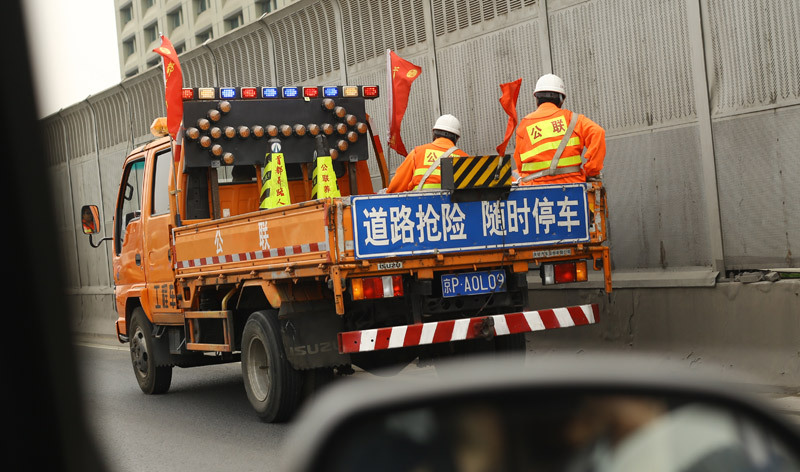
Bottom contrast garbage for color blind. Next, the blue retroreflective plate. Above they are driven cones for installation over 30 meters. A lot of fluttering flags. LED sign with a huge sign. Even higher - flashers. What is missing is the inscription "This is not spam." But seriously - there are special flashing signs on sharp turns (the same color code as the road car and the local traffic police).
Multiple indications are many where. For example, icons play a very important role: the fact is that not all citizens (especially from a village) are able to read something difficult. Hieroglyphs are not letters, there are a lot of them. They need to be taught. Of course, navigation is written simply, but almost always duplicated, so as not to get confused:

The first icon is the TV tower, the object where to go. Then - the moving arrow. Then - the inscription "entrance" in two languages. Then - the little man who finishes the whole picture.
In general, any thing that can be misunderstood will be displayed many times in many ways:

Tips: 1. Order from OFF to bottom. By the way, pay attention to the character, very indicative. 2. Indication I-II-III. 3. Color indication. 4. Some HML. 5. LED "running-not working" and depressed button position.
But what happens when there is no numerous indication:
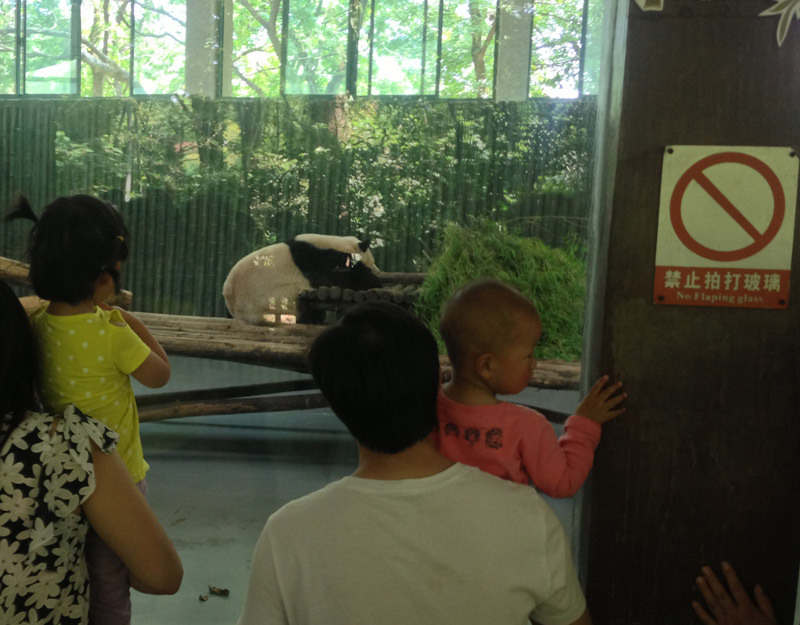
For many Chinese, there is just a sign of a ban, but what exactly is forbidden is not drawn.
Outlets in hotels are such that you can poke any fork and get:

From above - our “typical” 220 V under two round pins, into which the “Allied” 220 V is just as easily stuck under two flat pins. Below is a classic Chinese triangular. I photographed the local game, but it turned out to be the only normal frame with a rosette.
So that you can enter a password for a Wi-Fi without a Chinese keyboard, here’s a QR code that is enough to scan:

The work with the light and focusing of the locus of attention is very good. Here are the lights, they also have a source of lighting near asphalt, so that a person does not run across his feet on the open hatches:

But doing so in crowded places with stairs (LED cord). And the stairs are beautiful from afar, and the tourists do not hurt themselves. One day this will be understood by us, perhaps:

We watched Last Exile, where were the chess for airships - with fixation? Here is a thermos for the train. He has a neck like a teapot, but it is blocked. The button on the handle opens the opportunity to pour out of the thermos. This is a classic error insurance. Use a potentially dangerous function can only consciously.

It is also a foolproof, in particular, important for safety. We have a machine in production, which is able to break through with a guillotine knife a huge pack of paper at once. So, to start it, you need:
We return to China and continue. An ordinary spoon for yogurt is not going at all like in Europe. Gently, with a click, it is firmly fixed and bends after that in both directions, and not into one, as usual. Similar I met in Greenland, but she broke down on trying to compare her with her Chinese sister:

In general, the holders for all sorts of food - a separate part of the art. Here for a watermelon (and, yo-yo, when they are waiting for buyers, they buy seeds from it!):

The handles of various objects are a separate story in general, so now I will not dwell on it for a long time. Just show high-tech, which is already becoming familiar in some places here. This is a bamboo forest, a traditional wilderness lamp design. From above - the solar panel, from below - a deep reflector, at the bottom of which there are super-bright LEDs. The panel serves as a diffuser diffuser, so that the light is soft:

At traffic lights, a progress bar is used for red (no time). And the progress bar is often non-equilibrium - the first 50% of the scale run about 25% of the time. This solves a very simple Moscow problem - when you see 90 seconds at a traffic light, you want to run across (there was even such a study).

But for the green is important accurate assessment:

The concepts of "left" and "right" are absolute among some of the population and are associated with the south. Accordingly, when you are facing south (in the sun), you are left where you usually are. When you face north, left is on your right. Sometimes. And not for everyone. Perhaps that is why, at train stations and in other closed spaces, supporting navigation with the sides of the world is used:
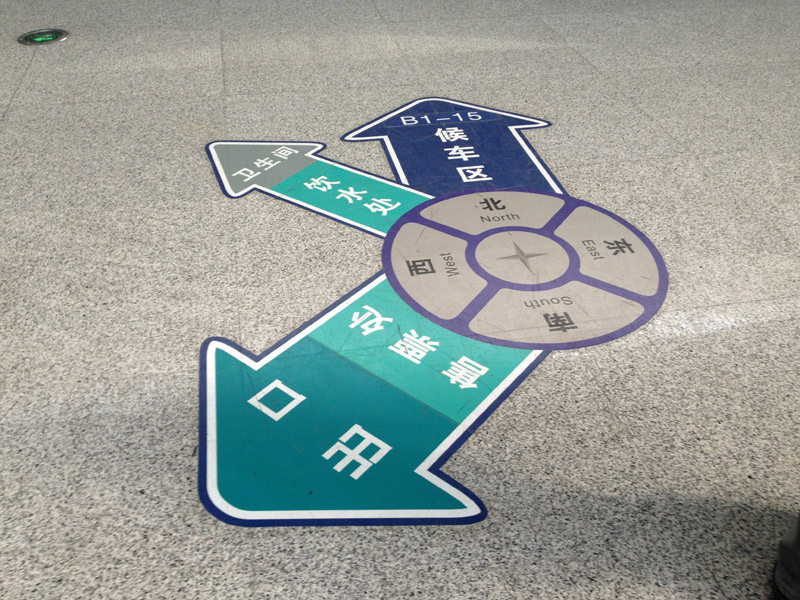
Here is a single find: special boxes for things in a cafe (by the way, the 2GIS developers showed me a split Ikeev backpack):

The cups are made of paper — triangles that you don’t take with you, you need to drink water on the spot and throw it away. Apparently, they were carried away home, because the good is lost:

There are often washstands for children (now they are often found in Moscow):

In the cafe canshare a recipe to share the check:

But already engineering solutions. Due to frequent rains, most surfaces are protected from slipping in various ways:


Bricks are delivered ready to carry:

Key banks differs from European:

But try to guess about the purpose of these three things:

Time

Two

Three
Another interesting thing is that ATMs at the airport spoke in the first person “tell me your PIN code” and “I only have 100 bills left, how much money should I give out?”. In the banks are often points +1 for pensioners. The card in the room that turns the light on or off turns off the power not immediately after the circuit is opened, but after 15 seconds - so that the guest can calmly leave the room with the light. In the capitals, the 3D glasses are very large - they are made so that you can fasten them on top of the optical glasses, because there are a lot of glasses among the Chinese. In theaters, the rooms on the chairs glow either on the LEDs or on the phosphor, which is very convenient for finding a place after the beginning of the performance.
In taxis, traditional interfaces also intersect with high-tech. So that the driver is not distracted from the road, the voice orders interface. The female robot reads the order, the taxi driver has 3-5 seconds to take it. Did not take - that's the next one. A dummy robot is cheerful and often, when there is no text entry in the database (apparently, there is convergence with some legacy interface for receiving calls), it just includes a piece of telephone conversation or radio transmission by the taxi service. And the driver has a ticket office that records the time of the trip, shows the fare, shows in real time what the price is made of (standing time and mileage), and at the end gives a check. This is the same state of control transmitted by the interface by the user (due to complete information about the process).
Finally - my favorite gamification, more precisely, learning by game. This is the game "perevesh elephant", after which the Chinese children who looked into the zoo, will have a clear physical understanding of the mass (more precisely, in this case, the weight) of the elephant:

We have similar effects in interactive museums, but it seems that zoos are not yet placed on IT. Although there is no swing here - just a strain gauge under the right cradle, some Raspberry Chinese spill and scoreboard. I suspect that if the scoreboard is replaced with a cheap screen, children can do this themselves at school or at the elective and give even a very small zoo. An elephant will sculpt or draw longer.
PS And yes, if you're interested further, two more posts about interfaces in the real world.

Icons are important. Judging by them, the tick below is, almost certainly, "I agree with the terms." The phone number at the top is probably a number. Next - the lock is the password. Both fields are active, that is, I must have a username and password right away, right?
')
No, nifiga, the Chinese UX means that I will first enter the phone and press the orange button (the colors of the icon - and yes, this is the button!). I will receive the password and enter it in the second field, and then press the green button. The robot will compare the phone with a password and let me go on. This form is most likely painted by a Chinese.

And this is the usual telephone booth of the early space age
Now I will show a few more things born in a country where there are about twenty times more qualified engineers than in America, and the state of inventiveness of the “Soviet engineer” has not yet passed. Of course, I will continue my story again and show the interfaces in the real world - they are no less interesting from the point of view of usability than HCI, and no less useful for understanding how to work with the user.
But the same form as above, only drawn by a European:

But let's go ahead and see what interesting things Chinese thought gives rise to. Here is the "do not disturb" checkbox on the switch. Because the switch is a natural chebox. They turned on in the room, your display lit up, a sign lit up in the hallway outside the door.

Here is a similar element in iOS:

This composition suggests that the Chinese love backups and think with their heads about emergency situations. In expensive hotels almost everywhere there is a shelf for a telephone in the bathroom and a parallel telephone. There is also the same switch as above about “do not disturb”, only with the words “ask the guest to wait”.

Here is this thing complement each tourist at the hotel reception:

On the front side it says something like “take this idiot to a hotel at such-and-such address”, on the B side, addresses to poke a finger into the taxi driver. Bottom line - a number is written into it when a taxi was ordered by a concierge so that a stupid tourist would not lure the car. Elegant and very cool. You encounter a roughly similar navigation pattern several times a day:

Spade smartphones have long been a part of culture. Here, for example, in the train holder. We still have to poke the phone in a jacket or wrap it in a towel and put it on the net shelf:

The issue with children and tickets is solved very cool. Let me remind you of our age. An age without complicated movements cannot be checked. In China, the check interface is many times simpler (yes, accuracy suffers a little, but this is not the main thing, right?):

Continuing about the hotel - there is often a “mixing console” near the bed, on which all the room switches are connected. You can turn off the light in the toilet without getting up.

Below, by the way, are often a respirator, an oxygen bottle and white slippers.
Here is more interesting. Some panels are full duplex, that is, when you click "turn off" change the state and controlled switch. In this case, the switch is a touch panel - it is quite difficult for the physical to click. That is, we change the predictability of the interface to the convenience of the user. On the other hand, most of the panels create a second break in the circuit, and in order to turn the light back on, you must first close the circuit from the panel again. But the switches are good old mechanical. The global OS control panels seem to behave remotely - sometimes you can reach the settings of something only from there, sometimes from the application, and sometimes from the application and from the panel, and what you end up with and survive is a surprise.
But we will continue. So that the client does not put something extra in the package, we tie it up. In China, they simply print a zero price tag on the scales and stick it to them. Excellent use of not only the information component (code), but also the media. Such a glue without damage to the package will not lag behind:

Given that the main problem of the country is to cope with different types of DDoS on infrastructure due to the large number of users, excellent solutions are born. Here, for example, there are toilets in the train separately, and washrooms separately. The excellent principle of TRIZ is separation. Now, cleaning teeth do not break the lives of those who ate something wrong:

So that you better understand the depth of the problem of busy toilet, please note that the trains there are three-storeyed:

Anything that can be poddoseno will be poddoseno. Plus, they do not believe in the queue here, and therefore they immediately build a whole system of labyrinths around the cash registers. The labyrinth architecture itself forces people to keep order. This is also a great interface example of learning. Here you can not do wrong, even if you come from the village do not know how to stand in line:

Accordingly, if “it is impossible” - then it is not a symbol, but a physical limitation. For example, all double solid on the main roads of Beijing at least 40 centimeters in height and of concrete. Or hello to the electricians:

Very often animation is used to indicate dangerous things - because moving things are more visible. At night on the dangerous parts of the road LED moving arrows or flashers. But the machine that can stand and repair the track.

Bottom contrast garbage for color blind. Next, the blue retroreflective plate. Above they are driven cones for installation over 30 meters. A lot of fluttering flags. LED sign with a huge sign. Even higher - flashers. What is missing is the inscription "This is not spam." But seriously - there are special flashing signs on sharp turns (the same color code as the road car and the local traffic police).
Multiple indications are many where. For example, icons play a very important role: the fact is that not all citizens (especially from a village) are able to read something difficult. Hieroglyphs are not letters, there are a lot of them. They need to be taught. Of course, navigation is written simply, but almost always duplicated, so as not to get confused:

The first icon is the TV tower, the object where to go. Then - the moving arrow. Then - the inscription "entrance" in two languages. Then - the little man who finishes the whole picture.
In general, any thing that can be misunderstood will be displayed many times in many ways:

Tips: 1. Order from OFF to bottom. By the way, pay attention to the character, very indicative. 2. Indication I-II-III. 3. Color indication. 4. Some HML. 5. LED "running-not working" and depressed button position.
But what happens when there is no numerous indication:

For many Chinese, there is just a sign of a ban, but what exactly is forbidden is not drawn.
Outlets in hotels are such that you can poke any fork and get:

From above - our “typical” 220 V under two round pins, into which the “Allied” 220 V is just as easily stuck under two flat pins. Below is a classic Chinese triangular. I photographed the local game, but it turned out to be the only normal frame with a rosette.
So that you can enter a password for a Wi-Fi without a Chinese keyboard, here’s a QR code that is enough to scan:

The work with the light and focusing of the locus of attention is very good. Here are the lights, they also have a source of lighting near asphalt, so that a person does not run across his feet on the open hatches:

But doing so in crowded places with stairs (LED cord). And the stairs are beautiful from afar, and the tourists do not hurt themselves. One day this will be understood by us, perhaps:

We watched Last Exile, where were the chess for airships - with fixation? Here is a thermos for the train. He has a neck like a teapot, but it is blocked. The button on the handle opens the opportunity to pour out of the thermos. This is a classic error insurance. Use a potentially dangerous function can only consciously.

It is also a foolproof, in particular, important for safety. We have a machine in production, which is able to break through with a guillotine knife a huge pack of paper at once. So, to start it, you need:
- Put the paper under the paper sensor
- Put your left hand on the left start button far left
- The right hand is on the right trigger button far to the right.
- Press the pedal with your foot (in this position it is physically impossible to stick your head into the working area of the machine)
- Press both start buttons at the same time.
- But, apparently, the workers learned to act together or to block the buttons - and therefore still need to remove everything from the working area, so that the infrared rays do not overlap. Only after this start will happen.
We return to China and continue. An ordinary spoon for yogurt is not going at all like in Europe. Gently, with a click, it is firmly fixed and bends after that in both directions, and not into one, as usual. Similar I met in Greenland, but she broke down on trying to compare her with her Chinese sister:

In general, the holders for all sorts of food - a separate part of the art. Here for a watermelon (and, yo-yo, when they are waiting for buyers, they buy seeds from it!):

The handles of various objects are a separate story in general, so now I will not dwell on it for a long time. Just show high-tech, which is already becoming familiar in some places here. This is a bamboo forest, a traditional wilderness lamp design. From above - the solar panel, from below - a deep reflector, at the bottom of which there are super-bright LEDs. The panel serves as a diffuser diffuser, so that the light is soft:

At traffic lights, a progress bar is used for red (no time). And the progress bar is often non-equilibrium - the first 50% of the scale run about 25% of the time. This solves a very simple Moscow problem - when you see 90 seconds at a traffic light, you want to run across (there was even such a study).

But for the green is important accurate assessment:

The concepts of "left" and "right" are absolute among some of the population and are associated with the south. Accordingly, when you are facing south (in the sun), you are left where you usually are. When you face north, left is on your right. Sometimes. And not for everyone. Perhaps that is why, at train stations and in other closed spaces, supporting navigation with the sides of the world is used:

Here is a single find: special boxes for things in a cafe (by the way, the 2GIS developers showed me a split Ikeev backpack):

The cups are made of paper — triangles that you don’t take with you, you need to drink water on the spot and throw it away. Apparently, they were carried away home, because the good is lost:

There are often washstands for children (now they are often found in Moscow):

In the cafe can

But already engineering solutions. Due to frequent rains, most surfaces are protected from slipping in various ways:


Bricks are delivered ready to carry:

Key banks differs from European:

But try to guess about the purpose of these three things:

Time

Two

Three
Another interesting thing is that ATMs at the airport spoke in the first person “tell me your PIN code” and “I only have 100 bills left, how much money should I give out?”. In the banks are often points +1 for pensioners. The card in the room that turns the light on or off turns off the power not immediately after the circuit is opened, but after 15 seconds - so that the guest can calmly leave the room with the light. In the capitals, the 3D glasses are very large - they are made so that you can fasten them on top of the optical glasses, because there are a lot of glasses among the Chinese. In theaters, the rooms on the chairs glow either on the LEDs or on the phosphor, which is very convenient for finding a place after the beginning of the performance.
In taxis, traditional interfaces also intersect with high-tech. So that the driver is not distracted from the road, the voice orders interface. The female robot reads the order, the taxi driver has 3-5 seconds to take it. Did not take - that's the next one. A dummy robot is cheerful and often, when there is no text entry in the database (apparently, there is convergence with some legacy interface for receiving calls), it just includes a piece of telephone conversation or radio transmission by the taxi service. And the driver has a ticket office that records the time of the trip, shows the fare, shows in real time what the price is made of (standing time and mileage), and at the end gives a check. This is the same state of control transmitted by the interface by the user (due to complete information about the process).
Finally - my favorite gamification, more precisely, learning by game. This is the game "perevesh elephant", after which the Chinese children who looked into the zoo, will have a clear physical understanding of the mass (more precisely, in this case, the weight) of the elephant:

We have similar effects in interactive museums, but it seems that zoos are not yet placed on IT. Although there is no swing here - just a strain gauge under the right cradle, some Raspberry Chinese spill and scoreboard. I suspect that if the scoreboard is replaced with a cheap screen, children can do this themselves at school or at the elective and give even a very small zoo. An elephant will sculpt or draw longer.
PS And yes, if you're interested further, two more posts about interfaces in the real world.
Source: https://habr.com/ru/post/268211/
All Articles